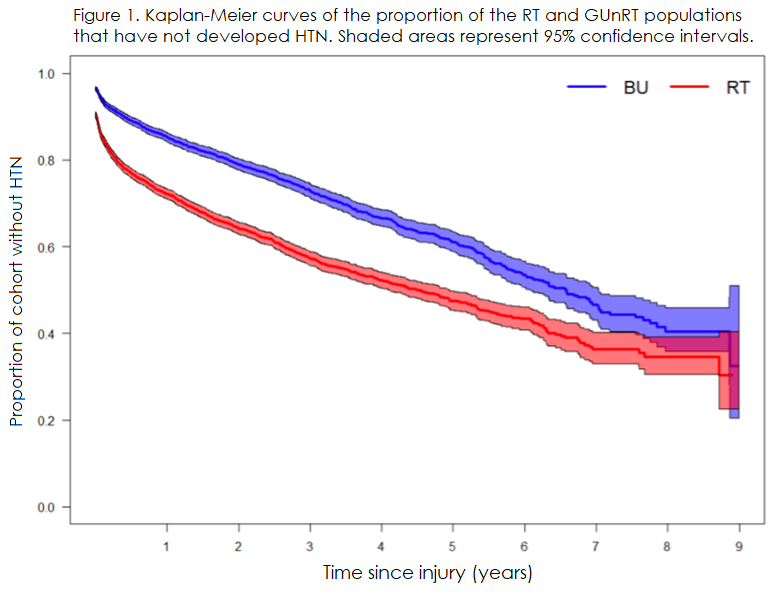Back
Poster, Podium & Video Sessions
Podium
PD29: Trauma/Reconstruction/Diversion: External Genitalia Reconstruction and Urotrauma (including transgender surgery) II
PD29-02: Risk of Hypertension after Renal Trauma
Saturday, May 14, 2022
1:10 PM – 1:20 PM
Location: Room 244
Matthew S Swallow*, Odinachi I Moghalu, Joshua J Horns, Benjamin J McCormick, Jeremy B Myers, Salt Lake City, UT
- MS
Podium Presenter(s)
Introduction: The risk of hypertension after renal trauma (RT) is not well-defined. Previous studies are limited by small cohorts and/or difficulty in long-term follow up after trauma. We aimed to utilize the Truven Health MarketScan (MS) database to evaluate the risk of hypertension after RT.
Methods: We conducted a retrospective analysis of inpatient records in MS from 2008-2017 for patients with renal and bladder/urethral trauma. Patients with a diagnosis of RT or non-renal lower genitourinary trauma (GUnRT) (bladder/urethral trauma) were identified through ICD-9/10 codes. The development of HTN (also defined by ICD-9/10 codes) was compared between those who experienced RT and a control group of those who experienced GUnRT. Patients were excluded if they experienced both trauma types, had pre-existing HTN, had less than one year of enrollment data prior to trauma, or if they were under 18 years of age. An adjusted analysis included multiple covariates.
Results: There were a total of 6,542 RT patients and 5,144 GUnRT patients. The median age was 52 years (IQR 31-65) for RT patients and 49 years (IQR 38-64) for GUnRT patients. Median follow up data was 18 months (IQR 6-38) for RT patients and 21 months (IQR 7-42) for GUnRT patients. A total of 2,232 (34.1%) RT patients developed post-trauma HTN compared to 1,194 (23.2%) GUnRT patients. On multivariate analysis, risk of post-trauma HTN was higher in individuals with RT compared to GUnRT (hazard ratio 1.75, 95% CI 1.63-1.88, p<0.001). Other covariates associated with increased risk of post-trauma HTN included increasing age, female gender, increased Charlson Comorbidity Index, increased inpatient length of stay, and presence of one or more of the following comorbidities: smoking, diabetes, obesity, hyperlipidemia, and alcohol use. Undergoing either an open or minimally invasive kidney procedure was not associated with a higher rate of HTN (hazard ratio 1.095, 95% CI 0.94-1.27, p=0.239).
Conclusions: Patients experiencing renal trauma have an associated higher rate of developing hypertension compared to a control population. Patient age, female gender, and medical history of diabetes, obesity, and hyperlipidemia was also associated with increased risk of post-trauma HTN.
Source of Funding: University of Utah Division of Urology

Methods: We conducted a retrospective analysis of inpatient records in MS from 2008-2017 for patients with renal and bladder/urethral trauma. Patients with a diagnosis of RT or non-renal lower genitourinary trauma (GUnRT) (bladder/urethral trauma) were identified through ICD-9/10 codes. The development of HTN (also defined by ICD-9/10 codes) was compared between those who experienced RT and a control group of those who experienced GUnRT. Patients were excluded if they experienced both trauma types, had pre-existing HTN, had less than one year of enrollment data prior to trauma, or if they were under 18 years of age. An adjusted analysis included multiple covariates.
Results: There were a total of 6,542 RT patients and 5,144 GUnRT patients. The median age was 52 years (IQR 31-65) for RT patients and 49 years (IQR 38-64) for GUnRT patients. Median follow up data was 18 months (IQR 6-38) for RT patients and 21 months (IQR 7-42) for GUnRT patients. A total of 2,232 (34.1%) RT patients developed post-trauma HTN compared to 1,194 (23.2%) GUnRT patients. On multivariate analysis, risk of post-trauma HTN was higher in individuals with RT compared to GUnRT (hazard ratio 1.75, 95% CI 1.63-1.88, p<0.001). Other covariates associated with increased risk of post-trauma HTN included increasing age, female gender, increased Charlson Comorbidity Index, increased inpatient length of stay, and presence of one or more of the following comorbidities: smoking, diabetes, obesity, hyperlipidemia, and alcohol use. Undergoing either an open or minimally invasive kidney procedure was not associated with a higher rate of HTN (hazard ratio 1.095, 95% CI 0.94-1.27, p=0.239).
Conclusions: Patients experiencing renal trauma have an associated higher rate of developing hypertension compared to a control population. Patient age, female gender, and medical history of diabetes, obesity, and hyperlipidemia was also associated with increased risk of post-trauma HTN.
Source of Funding: University of Utah Division of Urology


.jpg)
.jpg)